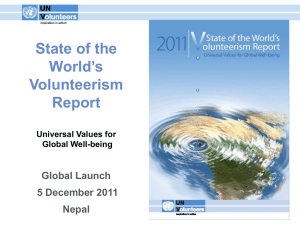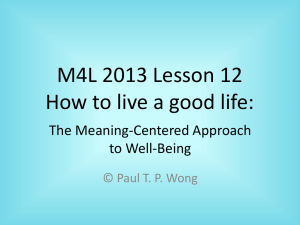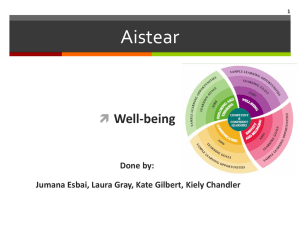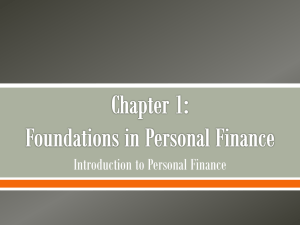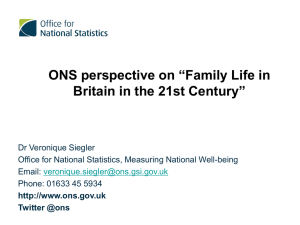How subjective well-being measures make a difference in policy
advertisement
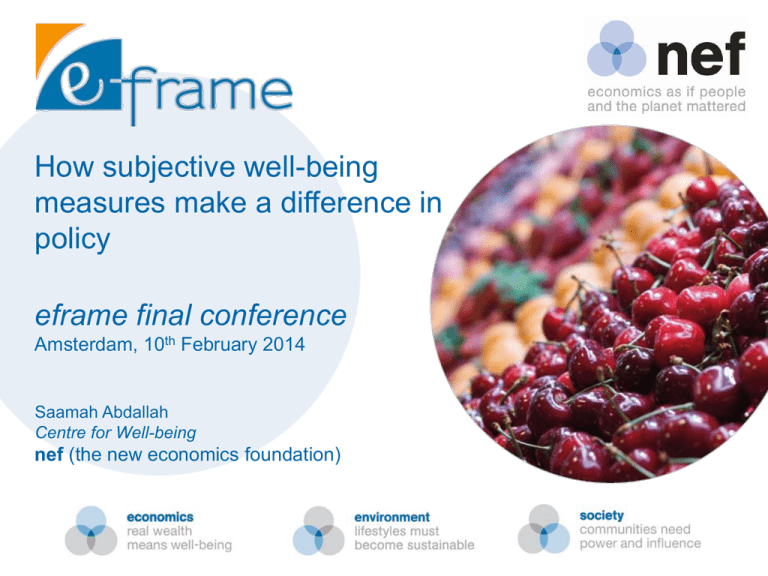
How subjective well-being measures make a difference in policy eframe final conference Amsterdam, 10th February 2014 Saamah Abdallah Centre for Well-being nef (the new economics foundation) Outline • Why measure well-being subjectively? • Approaches to measuring subjective well-being • Well-being measurement in Europe • Potential and actual uses About nef An independent UK think-and-do-tank (founded 1986). Inspired by 3 principles Sustainable development Social justice People’s well-being Aim of the centre for well-being: “Enhance individual and collective well-being in ways that are environmentally sustainable and socially just” Outline • Why measure well-being subjectively? • Approaches to measuring subjective well-being • Well-being measurement in Europe • Potential and actual uses Well-being is a property of people Well-being is inherently subjective “The most fundamental indicator of your happiness is how happy YOU feel, not whether others see you smiling, your family thinks you are happy, or you have all the presumed material advantages of a good life” (Helliwell & Wang, 2012) ‘Feeling’ good is universally desirable and important to people Subjective well-being is democratic Subjective well-being data can provide new insights Outline • Why measure well-being subjectively? • Approaches to measuring subjective well-being • Well-being measurement in Europe • Potential and actual uses A dynamic model of well-being Overall evaluation Evaluative & Hedonic Good feelings day-to-day Good functioning and satisfaction of needs e.g. to be autonomous, competent, connected to others External conditions e.g. material conditions, social capital Adapted from Foresight (2008) Capabilities Eudaimonic Personal resources e.g. health, resilience, optimism, selfesteem Theory – approaches to SWB 1. Evaluative 1. Life satisfaction & life satisfaction scales 2. Ladder of life approaches 3. Domain satisfaction 2. Hedonic 1. Affect measures 2. Experience sampling techniques 3. Eudaimonic 1. Flourishing approach 2. Capabilities approach 3. Being, doing, loving Outline • Why measure well-being subjectively? • Approaches to measuring subjective well-being • Well-being measurement in Europe • Potential and actual uses Subjective well-being measurement in Europe (in 2012) Official survey Semi-official survey No survey Did not respond Subjective well-being measurement in Europe By whom? • 34 surveys reviewed • 22 by official NSIs • 5 by other official bodies • 2 by Eurostat • 2 by other EU agencies • 2 by academic institutes • 1 by UNECE Type of survey? • 10 health • 8 well-being or quality of life • 5 general social • 2 perceptions • 5 material conditions • 1 environmental • 2 household Items used to measure subjective well-being • Life satisfaction (18 surveys) – “All things considered, how satisfied are you with your life as a whole nowadays? Please answer using this card, where 0 means extremely dissatisfied and 10 means extremely satisfied” – “Overall, how satisfied are you with your life nowadays?” Items used to measure subjective well-being • Domain satisfactions (15 surveys) 3 to over 10 items including... – Personal relationships (10) – Work or main activity (10) – Housing (8) – Health (8) Items used to measure subjective well-being • SF-10: “How much of the time, during the past 4 weeks…” – Did you feel full of life? – Have you been very nervous? – Have you felt so down in the dumps that nothing could cheer you up? – Have you felt calm and peaceful? – Did you have a lot of energy? – Have you felt down-hearted and depressed? – Did you feel worn out? – Have you been happy? – Did you feel tired? – (2 complete, 6 abbreviated) • Large literature (over 4000 publications) • BUT Ostensibly about mental health • and time-frame too long New recommendations... • OECD core affect measures (Guidelines for Measuring Subjective Well-Being) “The following questions ask about how you felt yesterday on a scale from 0 to 10. Zero means you did not experience the emotion ‘at all’ yesterday, while 10 means you experienced the emotion ‘all of the time’ yesterday” – Happy – Worried – Depressed • 7 other emotions covered in affect module Items used to measure subjective well-being • WEMWBS (Warwick Edinburgh Mental WellBeing Scale) “Below are some statements about feelings and thoughts. Please tick the box that describes your experience of each over the last two weeks” - I’ve been feeling optimistic about the future I’ve been feeling useful I’ve been feeling relaxed I’ve been dealing with problems well I’ve been thinking clearly I’ve been feeling close to other people I’ve been able to make up my own mind about things New options... • OECD eudaimonic module – – – – – In general, I feel very positive about myself [0-10] I’m always optimistic about my future [0-10] I am free to decide for myself how to live my life [0-10] I generally feel that what I do in my life is worthwhile [0-10] Most days I get a sense of accomplishment from what I do [0-10] – When things go wrong in my life it generally takes me a long time to get back to normal [0-10] – How much of the time yesterday... • you had a lot of energy? [0-10] • you felt calm? [0-10] • you felt lonely? Outline • Why measure well-being subjectively? • Approaches to measuring subjective well-being • Well-being measurement in Europe • Potential and actual uses Comparing nations or places Blackburn: IMD – 35.2 Flourishing – 21% nef (2012) Well-being patterns uncovered Hull: IMD – 37. 5 Flourishing – 27% Evaluation of project outcomes Big Lottery Fund well-being programme • £160 million working with 17 organisations and hundreds of projects – healthy eating, physical activity and mental health • Before and after evaluation methodology • Significant improvements also found up to 3-6 months later Evaluation of project outcomes National Citizen Service • Voluntary eight-week programme for 16-year olds on life skills and social action • Qualitative research highlighted – feelings of pride, achievement, overcoming fears and making a difference to others. NatCen & Cabinet Office Understanding drivers of well-being • Regression analyses can reveal associations between well-being and potential determinants, independent of compounding variables. • Controlling for standard demographics, we can normally be sure that a significant association either means: – Other variable determines well-being – Well-being determines other variable – Uncontrolled variable (e.g. personality) determines both • Longitudinal data helps to untangle these alternatives Understanding drivers of well-being • UK - Analyses of relationship between alcohol consumption and well-being have stressed the fact that highest well-being associated with moderate drinking (not no drinking) and influenced policy as a result. • Austria – Analyses have found independent positive effect for living in rural areas vs. Urban areas, highlighting importance of preserving opportunities to live in rural areas. Understanding drivers of well-being Eurofound European Quality of Life Survey, 2011 WB-informed policy appraisal (soft option) UK Cabinet Office: • WB impact tool • WB workshops – Policy on family doctors for elderly • Sciencewise – exploring well-being evidence with the public – Community rights (Dept. Communities and Local Govt) – Active labour market policy (Dept. Work and Pensions) – Loneliness interventions (Cabinet Office) Cost benefit analysis • Monetising outcomes based on their effect size on well-being vis-avis effect size of income – E.g. “living in a safe area = £1,456” • Cost well-being analysis: Combining effects on well-being without converting to €€€ Identifying priorities for policy action • ISTAT: Italian regions have been comparing satisfaction with different life domains to assess priorities Predicting future events Gallup data on well-being could have been used to predict Arab Spring in Egypt and Tunisia Redefining progress Thank you www.neweconomics.org www.happyplanetindex.org saamah.abdallah@neweconomics.org Recommendations • Standardise life satisfaction question • Harmonised domain satisfaction questions (see OECD guidelines) • Exploration of SF-10 and WHOQOL • Measure hedonic wellbeing and happiness correctly • Measure eudaimonic well-being • Ensure SWB measures accompanied by key drivers • Consider question order • Consider multidimensionality of SWB in analysis • Consider mode effects



